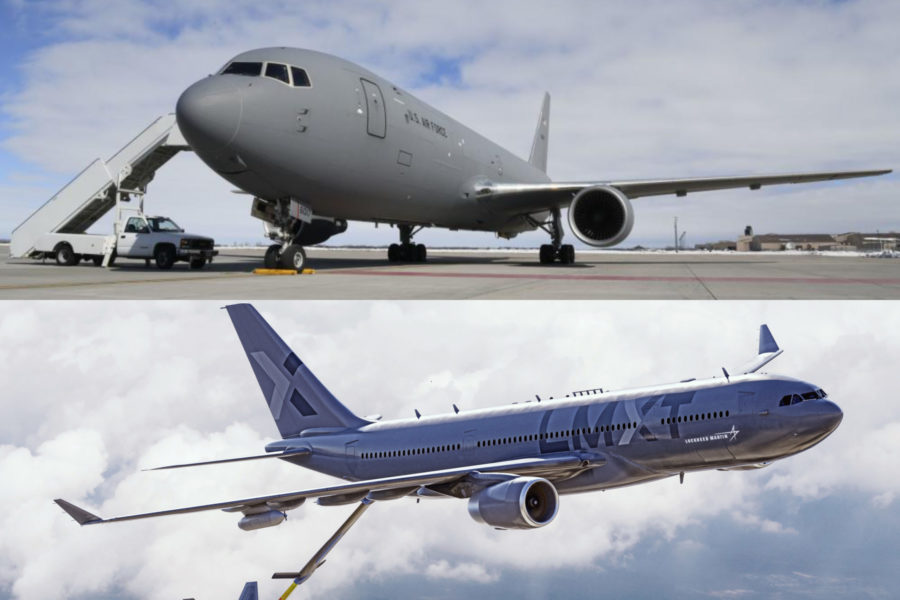Several lawmakers on the House Armed Services Committee were disappointed in their effort to force the Air Force into a competition for its KC-Y “bridge tanker.” Their proposed amendment failed to make it into the committee’s markup of the 2023 National Defense Authorization Act.
The panel did agree, however, to limit the service’s move to retire half its E-3 Sentry fleet before finally passing its version of the NDAA shortly after 2 a.m. June 23 by a bipartisan 57-1 vote.
KC-Y
Deep into the lengthy 16-hour markup process that started the morning of June 22, Rep. Jerry Carl (R-Ala.) introduced an amendment that would have prevented the Air Force from awarding any contract for its bridge tanker “unless such contract is awarded using full and open competition.”
Carl’s provision came in response to Air Force Secretary Frank Kendall’s remarks in recent months that the likelihood of a competition for the KC-Y—to bridge the gap between the KC-46 and the long-term vision for a “KC-Z”—has declined as the Air Force has done more work on the program.
“As we look for requirements, look further out, the requirements start to look like a modified KC-46 more than they do a completely new design,” Kendall told reporters in March. “So we’re working our way through finalizing those requirements. Again, we’ll be doing due diligence market research analysis.
“… I want to be very transparent about this. I think that there’s still a possibility for competition out there. But as we’ve looked at our requirements, the likelihood of a competition has come down.”
Thus far, only two companies appear to be interested in bidding for the contract. Lockheed Martin and Airbus have proposed their LMXT platform based on the Airbus A330 Multi-Role Tanker Transport, and Boeing is set to re-enter the KC-46 Pegasus.
The KC-46, however, has been plagued by a number of serious deficiencies, most prominently with its Remote Vision System, which has caused issues with refueling.
“We don’t have aircraft that work,” said Carl, citing those problems. “We do not have aircraft that fulfills 100 percent [of requirements]. … And now we’re being asked to turn the checkbook over to the Air Force. I refuse to allow that to happen. I encourage everyone to think and think hard on this one. We cannot let the DOD, the Air Force, any branch of the government, to continue to run away with our checkbook and do what they want to do. They have to be responsible.”
Carl represents Alabama’s 1st District, which includes Mobile, where Lockheed Martin has said it will build the LMXT.
On the other side of the issue, Rep. Donald Norcross (D-N.J.) proposed an amendment to Carl’s amendment effectively stripping it of its intent, allowing the Secretary of the Air Force to award a sole-source contract.
“The idea that somehow we’re just going to throw a check out the window and say, ‘Yeah, just keep buying them,’ is nowhere near the truth,” Norcross said. “We’re looking at unknown requirements that will probably not be here at the earliest until the end of the year. Yet we’re trying to make a decision that will box that in, telling you how you’ll have to do it, even before you know what we’re doing.”
In many ways, the debate over the proposals broke along parochial lines—Rep. Mike Rogers (R), also from Alabama, spoke in favor of Carl’s proposal, as did Rep. Anthony Brown (D) from Maryland, where Lockheed Martin is headquartered. Meanwhile, Rep. Rick Larsen (D-Wash.) and Rep. Joe Courtney (D-Conn.) advocated for Norcross’ amendment—Larsen represents Everett, Wash., where the KC-46 is built, and Courtney’s district borders Middletown, Conn., where the KC-46’s engines are made.
HASC chair Rep. Adam Smith, also from Washington, voiced support for letting the Air Force award a sole-source contract if it wants to, saying that doing so would allow the service to avoid contract protests that could drag the process out. He did, however, include a caveat.
“We will drive up the costs if we force them into a competition and force them into that more lengthy process,” Smith said. “Now, if we’re sitting here a year from now, and that camera doesn’t work and it’s not moving forward, we don’t have a choice at that point. We’ve got to go get something else.”
Ultimately, Norcross’ amendment was approved by a 36-22 vote, putting it in the NDAA that was passed by the entire committee, but the opposition warned it isn’t going away anytime soon.
“Just know this: If we lose today, this is coming back next year,” Rogers said before the vote.
E-3 Sentry
One provision also added to the NDAA that proved far less controversial was an amendment from Rep. Stephanie Bice (R-Okla.) that would restrict how and when the Air Force can start to retire its aging E-3 Airborne Warning and Control System (AWACS) fleet.
Language regarding the E-3 was already included in the chairman’s mark of the NDAA released June 20 that called for allowing just 10 E-3s to be retired until the Air Force reported back on its future airborne warning and control plans, and on developing air moving target indication, battle management, and command and control capabilities; the impact of retiring 15 AWACS planes; and a detailed comparison between the E-3s and the Air Force’s planned replacement, the E-7 Wedgetail.
Bice’s proposal, adopted as part of a package of amendments in a simple voice vote, would go beyond that, putting a hard cap of 13 aircraft that can be retired. And of those 13 planes, five could be retired only after the Air Force entered into a contract to procure the E-3’s replacement, the E-7 Wedgetail. That deal is not expected until at least fiscal 2023.
On top of that, Bice, whose district borders Tinker Air Force Base, where part of the E-3 fleet is located, called for two of the AWACS aircraft to be designated as training aircraft.
